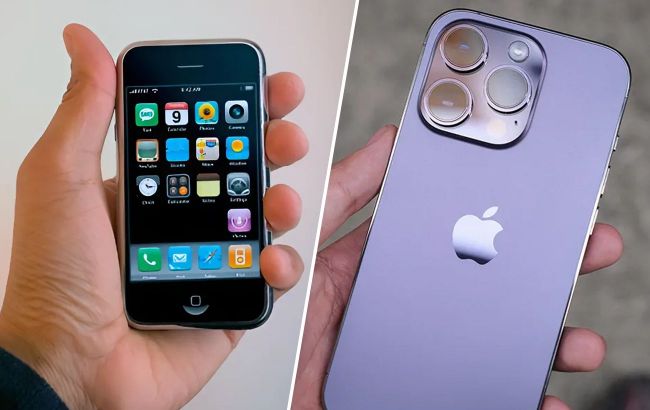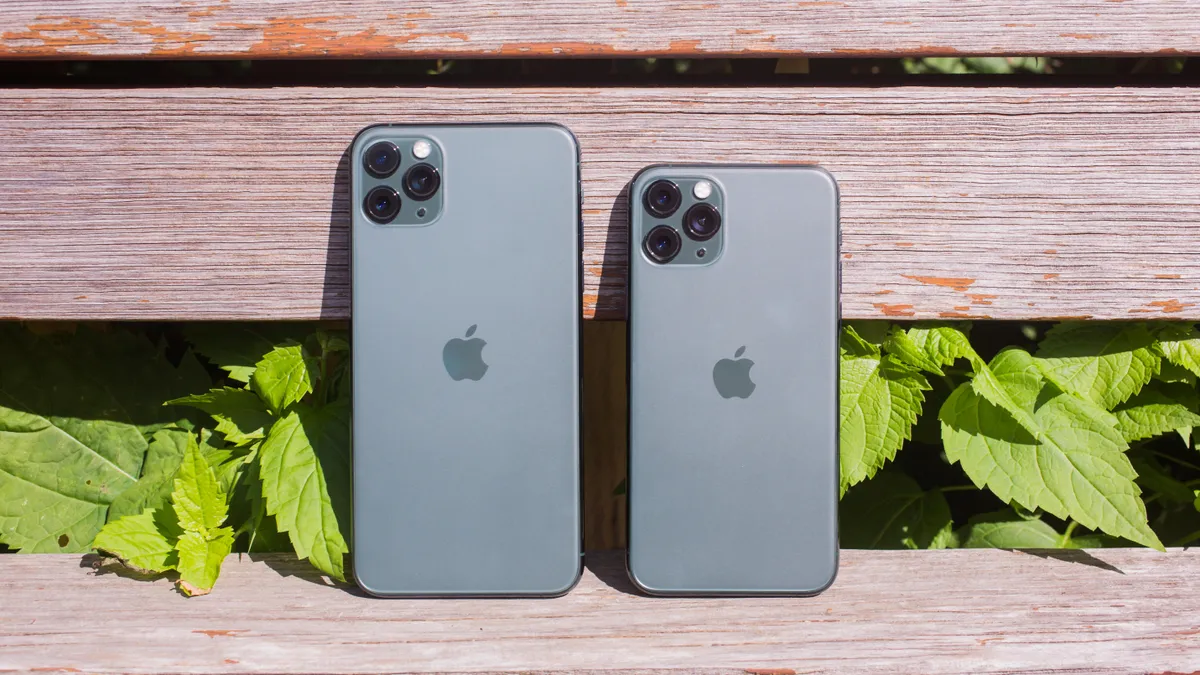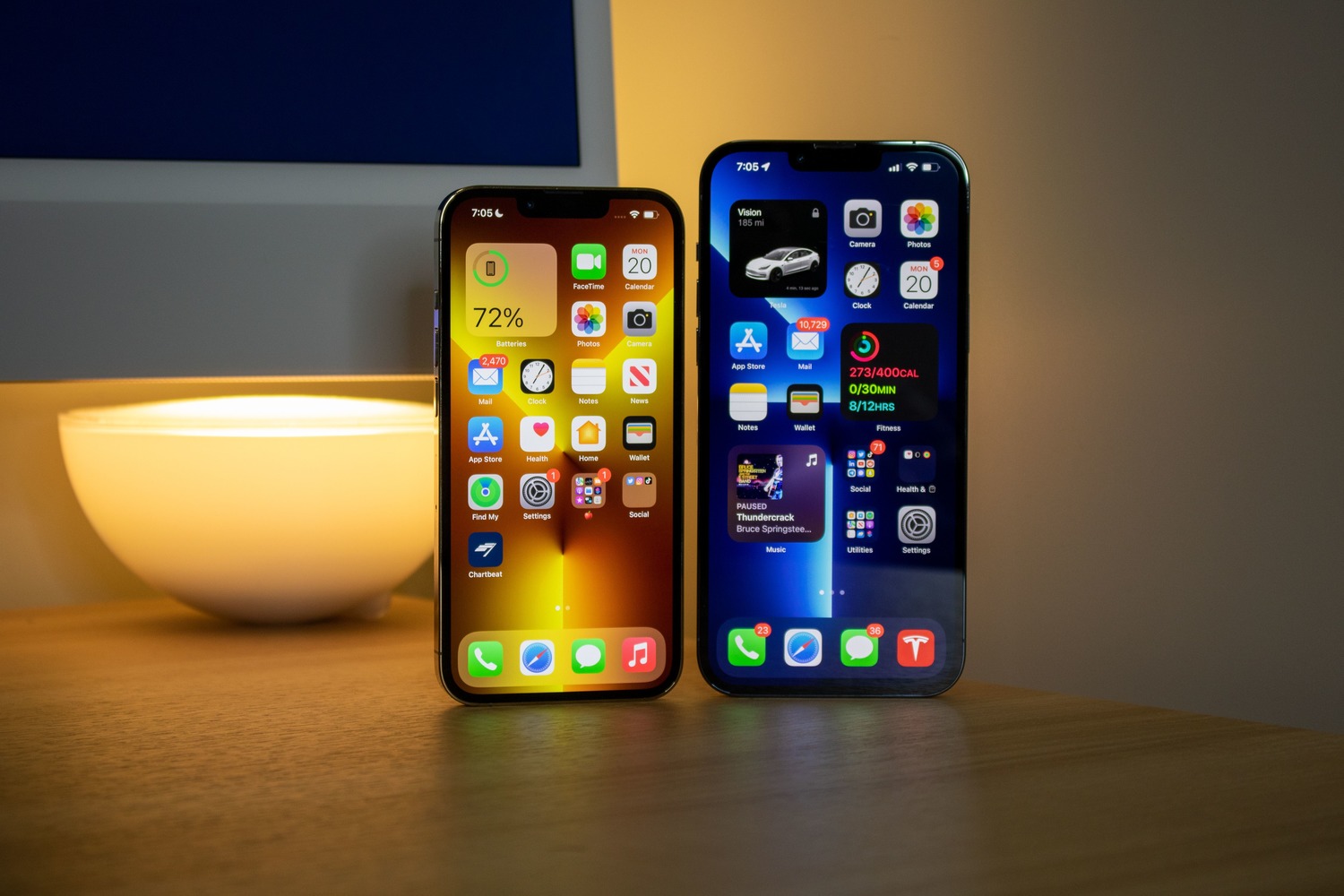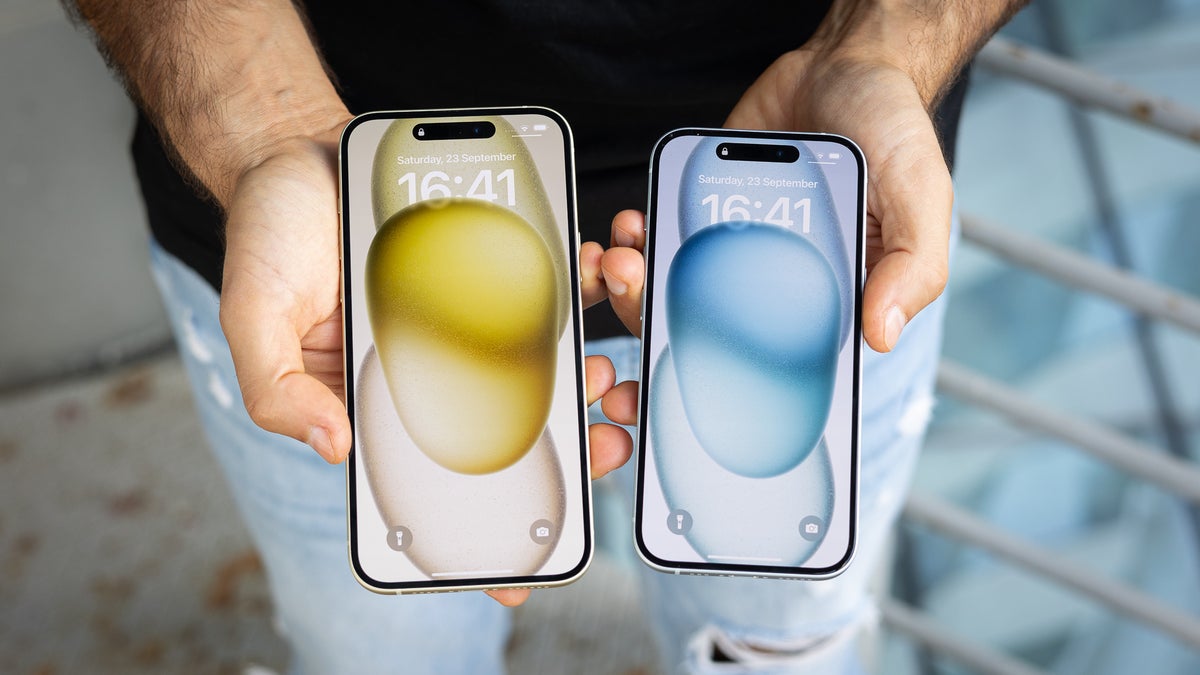Evolution of iPhone from 2007 to present
 How the world's most popular smartphone has changed from iPhone 2G to iPhone 15 (collage: RBC-Ukraine)
How the world's most popular smartphone has changed from iPhone 2G to iPhone 15 (collage: RBC-Ukraine)
On September 9, 2024, Apple unveiled its latest iPhone model. Over the years, the iPhone has set the standard in the smartphone market, introducing innovations annually. Today’s updates from Apple are impressive and elicit a wide range of emotions.
iPhone (iPhone 2G) (2007)
The iPhone 2G marked Apple’s debut in the smartphone market and initiated a significant revolution in mobile devices. It featured a 3.5-inch touchscreen and a 2-megapixel camera but lacked 3G support and third-party apps.

iPhone (iPhone 2G) (2007) (photo: Wikimedia)
iPhone 3G (2008)
The iPhone 3G, Apple’s second-generation model, introduced 3G network support, significantly enhancing data transfer speeds and app performance. It also debuted the App Store, enabling users to download and install apps, and added GPS for navigation.

iPhone 3G (2008) (photo: iMore)
iPhone 3GS (2009)
The iPhone 3GS offered improved performance, an enhanced camera, and new features, including video recording and voice control via Siri. This model made Apple’s products more accessible to the mass market, boosting their popularity.

Screenshot
iPhone 4 (2010)
The iPhone 4 marked a new phase in smartphone evolution with its sleek design featuring glass panels encased in a metal frame.
This model introduced the Retina display to Apple's lineup, offering incredibly sharp and vibrant content that immediately captivated users.
Additionally, it brought HD video recording capabilities and a second camera for FaceTime video calls.

iPhone 4 (2010) (photo: UPI)
iPhone 4S (2011)
This device was significant for Apple as it introduced Siri, a personal voice assistant that allowed users to interact with their devices through voice commands. The iPhone 4S featured an upgraded 8-megapixel camera and the Apple A5 processor for enhanced performance.

iPhone 4S (2011) (photo: UPI)
iPhone 5 (2012)
The iPhone 5 impressed users with its larger 4-inch screen and slim, stylish design, making it one of the most attractive smartphones on the market.
It introduced the new Lightning connector for charging and syncing. Additionally, the device supported LTE, providing faster internet access.

iPhone 5 (2012) (photo: CNET)
iPhone 5S (2013)
The iPhone 5S became the first smartphone to feature Touch ID fingerprint scanning technology. It also introduced the A7 processor, the first 64-bit chip in mobile devices.
An enhanced camera with larger pixels and a dual LED flash significantly improved photo quality in low-light conditions.

iPhone 5S (2013) (photo: TechCrunch)
iPhone 5C (2013)
The iPhone 5C featured a bright, colorful plastic casing, offering users more design options. Technically, it was similar to the iPhone 5, maintaining the same performance and display, but it was available at a more affordable price.

iPhone 5C (2013) (photo: TechCrunch)
iPhone 6 and iPhone 6 Plus (2014)
In this lineup, Apple increased the screen sizes to 4.7 and 5.5 inches, respectively, which quickly appealed to users.
These models featured a slimmer, more elegant design and were equipped with powerful A8 processors, delivering enhanced performance and graphics, as well as support for the new Apple Pay payment system.

iPhone 6 and iPhone 6 Plus (2014) (photo: Forbes)
iPhone 6s and iPhone 6s Plus (2015)
These models were equipped with the A9 processor and supported 3D Touch, an innovative technology that allowed the device to detect varying levels of pressure and respond with different functions.
The iPhone 6s and 6s Plus also featured an enhanced camera with Live Photos, capturing moments before and after the shot to add dynamism to photographs.

iPhone 6s and iPhone 6s Plus (2015) (photo: Forbes)
iPhone SE (2016)
The iPhone SE combined modern performance with the design of the iPhone 5s. It housed the A9 processor, delivering high performance and compatibility with the latest iOS versions, all at a more affordable price.
 iPhone SE (2016) (photo: Digital Trends)
iPhone SE (2016) (photo: Digital Trends)
iPhone 7 and iPhone 7 Plus (2016)
The iPhone 7 and iPhone 7 Plus delighted users with improved cameras, the powerful A10 Fusion processor, and a new glossy black color.
The iPhone 7 Plus featured a large 5.5-inch display and a dual camera system. Both models became water- and dust-resistant and offered enhanced sound quality.
In 2016, Apple removed the traditional headphone jack, requiring users to switch to Lightning headphones or purchase adapters for older headsets.

iPhone 7 and iPhone 7 Plus (2016) (photo: HardwareZone)
iPhone 8 and iPhone 8 Plus (2017)
In 2017, Apple released enhanced versions of its previous models with the powerful A11 Bionic processor and an updated design, featuring a glass back panel to support wireless charging. As with the previous version, these models did not include a headphone jack.

iPhone 8 and iPhone 8 Plus (2017) (photo: SlashGear)
iPhone X (2017)
The iPhone X introduced a radically new design with a bezel-less OLED display and replaced Touch ID with Face ID facial recognition technology. It was equipped with the A11 Bionic processor, providing high performance and augmented reality support.
The iPhone X became a symbol of innovation and style, featuring an impressive display, an enhanced camera, and a secure unlocking system, making it one of the most anticipated smartphones of its time.

iPhone X (2017) (photo: Macworld)
iPhone XR, iPhone XS, and iPhone XS Max (2018)
The iPhone XR offered a more affordable option with vibrant color choices and the powerful A12 Bionic processor. Meanwhile, the iPhone XS and iPhone XS Max provided high-quality OLED displays, enhanced cameras, and increased performance, establishing themselves as flagship models.
These three models provided users with a variety of choices in size, design, and functionality, introducing the latest technologies in the smartphone market.
 iPhone XR, iPhone XS, and iPhone XS Max (photo: Tom's Guide)
iPhone XR, iPhone XS, and iPhone XS Max (photo: Tom's Guide)
iPhone 11 (2019)
The iPhone 11 continued the success of the iPhone XR with several significant upgrades, including the A13 Bionic processor and an improved dual-camera system.
The smartphone was available in a range of vibrant colors and featured a Liquid Retina display, delivering rich and sharp images that enhanced the content viewing experience.

iPhone 11 (2019) (photo: PCMag)
iPhone 11 Pro and iPhone 11 Pro Max (2019)
These two models featured the powerful A13 Bionic processor, Super Retina OLED displays, and an enhanced triple-camera system designed for professional-grade photography and videography.
The smartphones stood out with advanced cameras offering Night mode, Portrait mode, and improved image stabilization, making them ideal for users seeking high-quality photo and video capabilities.

iPhone 11 Pro and iPhone 11 Pro Max (2019) (photo: CNET)
iPhone SE (2nd Generation) (2020)
In April 2020, Apple released the second-generation iPhone SE, offering high performance at an affordable price with the A13 Bionic processor. The smartphone retained the classic design of the iPhone 8 but featured an improved camera with Portrait mode and Smart HDR technology.

iPhone SE 2nd generation (2020) (photo: IGN)
iPhone 12 and iPhone 12 Mini (2020)
The iPhone 12 and iPhone 12 Mini featured a modern design with flat edges and Super Retina XDR OLED displays, delivering bright and contrast-rich images. Both models supported MagSafe wireless charging.
Equipped with the A14 Bionic processor, these devices enhanced performance and added 5G support, preparing them for future network advancements.

iPhone 12 and iPhone 12 mini (2020) (photo: Tom's Guide)
iPhone 12 Pro and iPhone 12 Pro Max (2020)
The iPhone 12 Pro and iPhone 12 Pro Max were flagship models featuring the A14 Bionic processor and an advanced triple-camera system enhanced with LiDAR technology for more precise depth sensing and expanded photography capabilities.
These models differed from the standard iPhone 12 versions with an improved Super Retina XDR OLED display and larger sizes, with the iPhone 12 Pro Max boasting the largest screen ever on an iPhone.

iPhone 12 Pro and iPhone 12 Pro Max (2020) (photo: Tom's Guide)
iPhone 13 and iPhone 13 Mini (2021)
The iPhone 13 lineup continued the tradition of combining stylish design with high performance, introducing the A15 Bionic processor and enhanced camera capabilities.
Both models featured Cinematic Mode for depth effects in video and supported ProRAW and ProRes technologies for professional content editing.

iPhone 13 and iPhone 13 mini (2021) (photo: PhoneArena)
iPhone 13 Pro and iPhone 13 Pro Max (2021)
The flagship iPhone 13 Pro and 13 Pro Max models featured the A15 Bionic processor and advanced camera technologies, including ProRAW and ProRes modes, as well as improved Night mode capabilities.
These devices were equipped with Super Retina XDR OLED displays with ProMotion support, ensuring smooth and responsive screen performance.

iPhone 13 Pro and iPhone 13 Pro Max (2021) (photo: CNN)
iPhone 14 and iPhone 14 Plus (2022)
The iPhone 14 and iPhone 14 Plus featured the A15 Bionic processor and introduced fast charging support along with new safety features, including Emergency SOS via satellite. These models eliminated the physical SIM card tray, offering users the option to use only eSIM.

iPhone 14 and iPhone 14 Plus (2022) (photo: CNET)
iPhone 14 Pro and iPhone 14 Pro Max (2022)
The iPhone 14 Pro and iPhone 14 Pro Max introduced the new A16 Bionic processor and an updated design featuring Dynamic Island in place of the traditional notch.
Dynamic Island displays system notifications, messages, and multimedia data. The camera was enhanced with a 48-megapixel sensor, significantly improving photo and video quality.

iPhone 14 Pro and iPhone 14 Pro Max (2022) (photo: Engadget)
iPhone 15 and iPhone 15 Plus
The base model iPhone 15 features a 6.1-inch Super Retina XDR display, the new A16 Bionic chip, an improved dual-camera system, and a USB-C port. It is available in various colors and boasts an updated design with flat edges.
The iPhone 15 Plus is similar to the iPhone 15 but comes with a larger 6.7-inch display, ideal for users who prefer a bigger screen for content viewing and gaming.

iPhone 15, iPhone 15 Plus (photo: PhoneArena)
iPhone 15 Pro and iPhone 15 Pro Max
The advanced iPhone 15 Pro features a 6.1-inch display and the new A17 Pro chip. It boasts enhanced triple-camera systems, including a telephoto lens, and a durable titanium frame. This model offers advanced shooting capabilities and additional features for professionals.
The iPhone 15 Pro Max is the most advanced model, with a 6.7-inch display. It includes all the features of the iPhone 15 Pro, along with further improved cameras and an advanced periscope telephoto lens for enhanced zoom. It is designed for those seeking the highest performance and capabilities.

iPhone 15 Pro, iPhone 15 Pro Max (Mashable)
Sources: WIRED, Verizon, History Cooperative.

